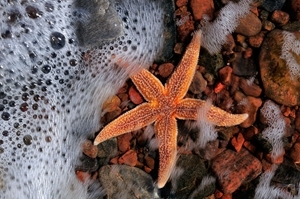Starfish
 The first thing to say is that starfish, or sea stars as they are often called, are not fish! They belong to the class of organisms known as Echinodermata. Echinoderms (meaning spiny-skinned) are invertebrates without a head and in the starfish’s case, have a hard skeleton under its skin and a body plan based on a (usually) five-pointed star shape with a mouth based in the middle. This group also includes other spiny species like sea urchins, sea cucumbers and brittle stars. There are around 1,500 different species of starfish in the world and around 32 species to be found in British waters.
The first thing to say is that starfish, or sea stars as they are often called, are not fish! They belong to the class of organisms known as Echinodermata. Echinoderms (meaning spiny-skinned) are invertebrates without a head and in the starfish’s case, have a hard skeleton under its skin and a body plan based on a (usually) five-pointed star shape with a mouth based in the middle. This group also includes other spiny species like sea urchins, sea cucumbers and brittle stars. There are around 1,500 different species of starfish in the world and around 32 species to be found in British waters.
Starfish move around by using hundreds of tube type feet, which are located on their underside, but these feet are important for a number of other uses too. As starfish have no blood, they instead use a water vascular system, sucking up sea water through their feet and using this to transport oxygen around their bodies, thereby ‘breathing’ through their feet.
These feet are also used to help the starfish eat mussels, clams and even barnacles. Once a suitable shellfish such as a mussel is found, the starfish goes to work on trying to force the shell open with its strong legs. Eventually the mussel tires and opens very slightly, but that tiny gap is all that is needed as the starfish’s stomach can now physically leave its body and be inserted into the mussel’s shell through the opening, where it then can digest the soft flesh inside at its own leisure! This feeding mechanism means that starfish can eat much larger prey than their tiny mouths would normally allow.
If a starfish is grabbed by one of its arms, it can allow its arm to drop off, letting it escape. It can then amazingly regenerate a new arm. In fact, a starfish can be left with as little as one quarter of its central disk after an attack, but can still regenerate itself over time back into a perfect specimen once more.
Scientists have known for some time that human foetuses can apparently effortlessly heal wounds without scar and that children up to the age of two can partially regrow amputated digits, so the potential for adult humans to regrow limbs may well also be possible.
By studying the genes from amphibians such as the salamander, alongside the humble starfish, scientists have made many new discoveries that are useful for limb regeneration, and a growing number now believe that it is time to develop the technology exploiting these discoveries to regrow human limbs.
So, maybe one day in the not too distant future, someone wandering along a beach spots a washed up starfish and stoops down to pick it up, using their newly regrown limb to do so. I wonder if they will be aware of the connection.
Peter Thompson
Advisory
Read more from Peter Thompson at the Fresh from the Field blog.
Photo © Laurie Campbell, used with kind permission.

Download Peter Thompson's essential 26-page book, featuring beautiful photography and detailed profiles of Britain's wildlife
Download FREE >